The iPhone 5 Review
by Anand Lal Shimpi, Brian Klug & Vivek Gowri on October 16, 2012 11:33 AM EST- Posted in
- Smartphones
- Apple
- Mobile
- iPhone 5
General Purpose Performance
Section by Anand Shimpi
Apple's philosophy on increasing iPhone performance is sort of a mix between what Microsoft is doing with Windows Phone 7/8 and what the high-end Android smartphone makers have been doing. On the software side Apple does as much as possible to ensure its devices feel fast, although I notice a clear tendency for newer iOS releases to pretty much require the latest iPhone hardware in order to maintain that speedy feel over the long haul. When it comes to hardware, Apple behaves very much like a high-end Android smartphone vendor by putting the absolute fastest silicon on the market in each generation of iPhone. The main difference here is that Apple controls both the software stack and silicon, so it's able to deliver a fairly well bundled package each year. It's a costly operation to run, one that is enabled by Apple's very high profit margins. Ironically enough, if Apple's competitors would significantly undercut Apple (it doesn't cost $599 - $799 to build a modern smartphone) I don't know that the formula would be able to work for Apple in the long run (Apple needs high margins to pay for OS, software and silicon development, all of which are internalized by Apple and none of which burden most of its competitors).
Good cross platform benchmarks still don't really exist on smartphones these days. We're left describing experience with words and trying to quantify performance differences using web based benchmarks, neither of which is ideal but both of which will have to do for now. The iPhone 5 experience compared to the 4S is best explained as just being snappier. Apps launch faster, scrolling around iOS Maps is smoother, web pages take less time to load and the occasional CPU/ISP bound task (e.g. HDR image processing) is significantly quicker. If you're the type of person who appreciates improvements in response time, the iPhone 5 delivers.
How does it compare to the current crop of high-end Android smartphones? I would say that the 5 generally brings CPU performance up to par with the latest and greatest in the Android camp, and in some cases surprasses them slightly. It's difficult making cross platform comparisons because of huge differences in the OSes as well as separating out tasks that are CPU bound from those that simply benefit from a higher rendered frame rate.
I took a cross section of various web based benchmarks and looked at their performance to help quantify where the iPhone 5 stands in the world. First up are the RIABench focus tests, these are javascript benchmarks that focus on various compute bound tasks. I used Chrome for all Android devices to put their best foot forward.

This first test shows just how slow the 800MHz Cortex A9s in the iPhone 4S were compared to the latest and greatest from Qualcomm and NVIDIA. At roughly half the clock speed of those competitors, the 4S was just much slower at compute bound tasks. Apple was able to mask as much of that as possible with smooth UI rendering performance, but there was obviously room for improvement. The iPhone 5 delivers just that. It modernizes the iPhone's performance and inches ahead of the Tegra 3/Snapdragon S4 platforms. Only Intel's Atom Z2460 in the Motorola RAZR i is able to outperform it.
Next up is Kraken, a seriously heavy javascript benchmark built by Mozilla. Kraken focuses on forward looking applications that are potentially too slow to run in modern browsers today. The result is much longer run times than anything we've seen thus far, and a very CPU heavy benchmark:
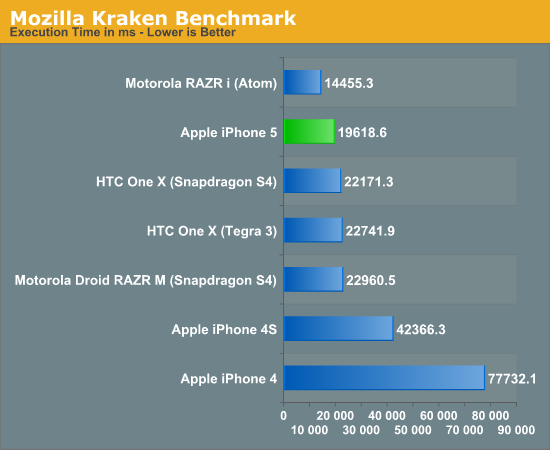
The standings don't change much here. The iPhone 4S is left in the dust by the iPhone 5, which steps ahead of the latest NVIDIA/Qualcomm based Android devices. The Apple advantage here is just over 10%. Once again, Intel's Atom Z2460 pulls ahead with the clear lead.
In our iPhone 5 Performance Preview we looked at Google's V8 javascript test as an alternative to SunSpider. The more data points the merrier:
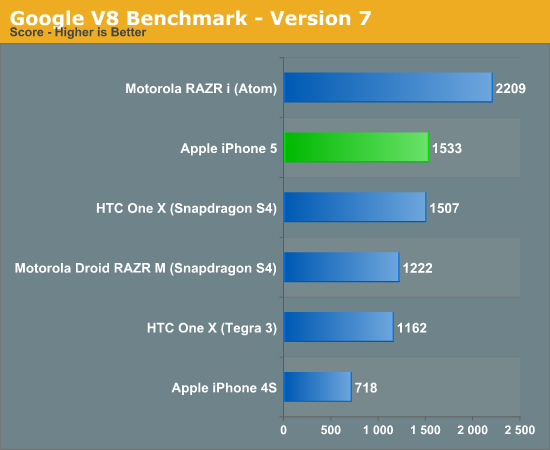
Here the iPhone 5 manages to hold onto its second place position, but just barely. Once more, the Atom based RAZR i maintains the performance lead.
Google's Octane benchmark includes all 8 of the V8 tests but adds 5 new ones including a PDF reader, 3D bullet physics engine and portable 3D game console emulator all built in javascript.
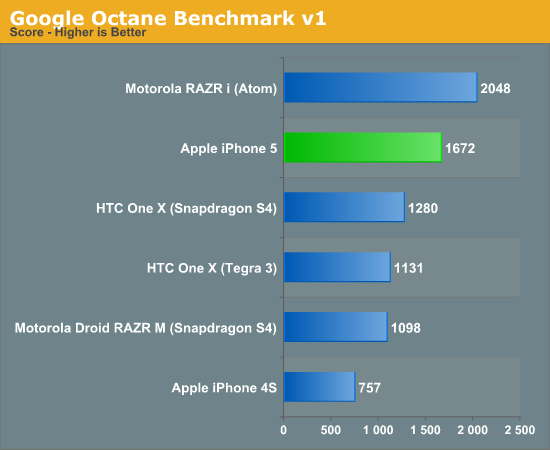
The 5 pulls ahead of the HTC One X here and maintains a healthy 31% lead, but once again falls short of the RAZR i.
We of course included our SunSpider and BrowserMark tests, both of which show the iPhone 5 very favorably:
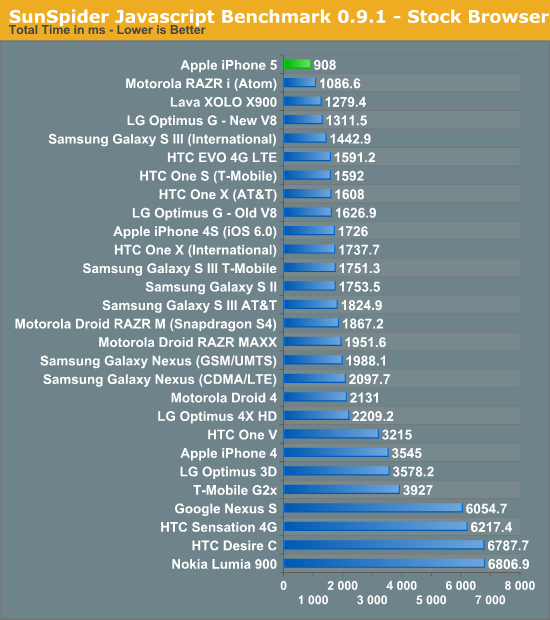
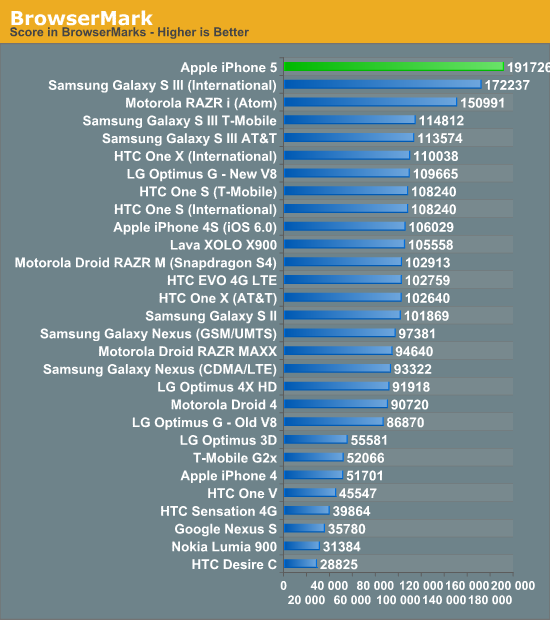
Performance obviously depends on workload, but it's clear the iPhone 5 is a big step forward from the 4S and tends to outperform the latest ARM based Android smartphones. As the rest of the ARM based SoC players move to Cortex A15 designs they should be able to deliver faster devices in the first half of 2013.
Intel's current position when it comes to CPU performance is interesting. A move to a dual-core design could be enough to remain performance competitive with 2013 ARM based SoCs. Remembering that Atom is a 5 year old CPU core that performs at the level of a 10 year old mainstream notebook CPU puts all of this progress in perspective. Intel's biggest issue going forward (other than getting Atom into more tier 1 phone designs) is going to be improving GPU performance. Luckily it seems as if it has the roadmap to do just that with the Atom Z2580.










276 Comments
View All Comments
KPOM - Wednesday, October 17, 2012 - link
However, Apple made a point about anodizing in its display. Also, Apple has historically placed a premium value on industrial design so it is interesting to read more specifics. What has struck me about Apple is how much time they devote to things people don't notice consciously or will never see on a spec sheet, but which can unconsciously affect the user experience. The aluminum has a nice feel to it, and I can see why Apple would forgo putting a resin coating on it, even though it would make it less susceptible to scratching. Understanding the physics helps make clear what kind of compromises Apple needs to make.phillyry - Sunday, October 21, 2012 - link
As per emotional input:I actually look for this in the review and podcasts because it colours the facts.
While I find the facts to be interesting and a good way to pass the time, at the end of the day my purchase decision, like those of human beings in general, will be largely guided by the sentiment of the matter.
People want to know how happy others are with their devices. Just facts alone lack humanity. I personally love hearing opinions, side comments and anecdotes that give me insight into the thoughts, feelings and experiences of people who's opinions I hold in high regard, such as anand and the gang.
There's something to be said for the qualitative experience that comes with the daily use of the device as your primary 'phone'.
Many others may also be looking to hear the comradery, jest, and fun-casual tone that you can get on this site when these guys just let their opinions out or go off on technical tangents. If you listen to the podcasts it'll all make more sense.
phillyry - Sunday, October 21, 2012 - link
P.S. the feeling that someone else, like anand, has about the device is also important because, if you are considering buying one of these things than you're going to have it for a couple of years and won't want to feel stuck with it.Spunjji - Friday, October 19, 2012 - link
I have to agree here... I already know how anodizing works (not specialist knowledge, we were taught in high-school...) and even if I didn't, I'm not sure a 'phone review is the best place to learn. An outside link would have sufficed. The whole thing does basically say that Apple had no choice in the matter unless they change the design, and that's really the point there. They should have changed the bloody design.arghhh - Tuesday, October 16, 2012 - link
How is it as a phone? Iphone never has been good at its primary function (I take an old clamshell over most smartphones in that regard).Arbee - Tuesday, October 16, 2012 - link
Brian Klug covered voice quality in this writeup, and AT's previous iOS 6 review covered the new voice call features. The upshot is it's at least as good as any other smartphone, even if no cellphone can replace a hardwired slab of mid-60s AT&T bakelite :)manik. - Tuesday, October 16, 2012 - link
Awesome read.Tangey - Tuesday, October 16, 2012 - link
The gpu comparison table shows the new iPad running @200mhz, it actually runs @250mhz ( as did the gpu in the ipad2). In a previous article you used this incorrect 200mhz as a reference point to determine that the iphone5 was running its gpu @266mhz.My calculations based on the iphone5's performance relative to the ipad3 @ 250mhz, indicate to me that the 543mp3 in the iphone5 is running in excess of 300mhz, most likely 325mhz, which also happens to be an exact divider of the 1.3ghz clock of the CPUs.
DustoMan - Tuesday, October 16, 2012 - link
Have you ever looked into why phones from certain manufactures are so picky about their chargers? I've had phones from HTC, Motorola, and Samsung and I've had three wildly different experiences when it comes to what chargers will work in what devices. When I had an HTC Incredible, I could stick pretty much anything I wanted to it and it would charge. If the charger didn't have much current, it would charge slower than a charger with my current. My Galaxy Nexus would work with a few of my chargers, but the oddest thing would happen when I would try connecting it to a Griffin car adapter that had the 1.5A plug necessary to charge a first gen iPad. The only plug that would charge it consistently was a car adapter that I purchased that was branded Samsung. Even an adapter that Verizon sold me as being compatible wouldn't work. Finally the worst offender is my wife's Droid 2 Global. It will only charge with a Motorola adapter. Adapters that work with my Galaxy Nexus, which you would think would need chargers with a higher current, wouldn't work. To charge her phone on my PowerMat, I have to plug the phone into a reserve battery and then use the Powermat to charge that reserve battery while it's charging her phone. Stupid huh?zephxiii - Tuesday, October 16, 2012 - link
Yes i recall Motorola's earlier microUSB equipped phones to be very picky....especially if the battery went completely flat as it seemed like only Motorola chargers (or compatible) would breathe life back into them.